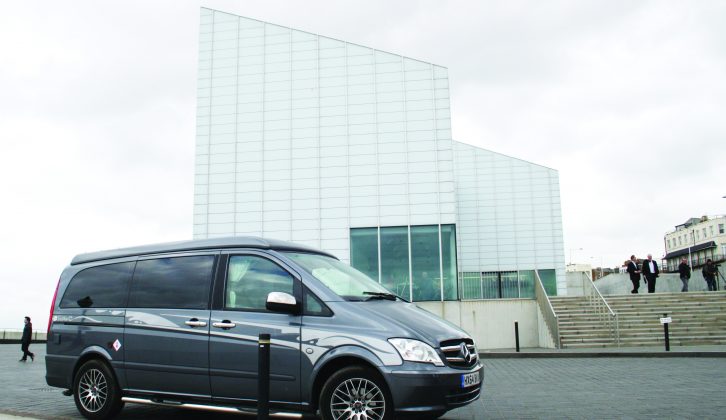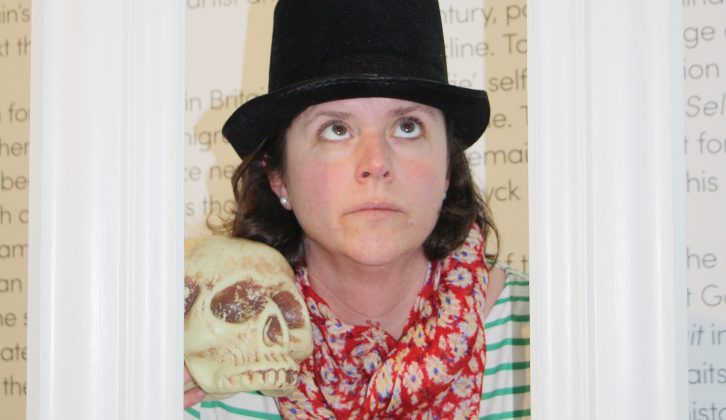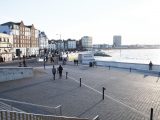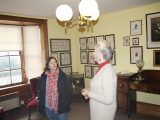Last year, the easternmost tip of Kent hit the headlines. Members of the public who may never previously have heard of Thanet were discussing its political importance, as lambasting UKIP leader Nigel Farage fought tooth-and-nail to take a seat in the House of Commons.
Prior to the 2015 general election, however, the Isle of Thanet was associated with seaside activities, not activists, having been a holidaymaker’s favourite ever since the tradition of ‘taking the sea air’ began in the 1700s.
But hang on – it’s not an ‘isle’ at all, is it? Not today, perhaps, but until around two centuries ago it was separated from the mainland by the Wanstum Channel, and has been known to be cut off in times of extreme flooding. Despite that, the area has been inhabited since the Stone Age, and we kept our fingers crossed that thunderstorms would stay away as we drove the Auto-Sleeper Wave along the A28, because our first stop near Birchington-on-Sea was on the edge of the area that was once under water.
The popularity of foreign holidays has taken its toll on visitor numbers to Kent’s most famous resorts, such as Margate and Ramsgate, but Thanet has been undergoing a real process of regeneration and Emma and I planned to relive our youths by taking a traditional British seaside holiday – albeit without much swimming in the sea in a chilly March. As well as that, we were keen to look beyond the seafront candyfloss and ‘kiss-me-quick’ hats to uncover the Thanet of today, a place that blends rich history with culture.
You don’t get much more historically or culturally significant than an association with Charles Dickens. The author first came to stay in Broadstairs in 1837, when he was 25, and instantly fell in love with the town, writing: “You cannot think how delightful and fresh the place is and how good the walks.” He never lived there, but returned to Broadstairs regularly over the following decade and a half, later writing Our English Watering Place as a tribute to the town.
In Miss Betsey’s footsteps
Emma is a voracious reader, so was very keen to visit the Dickens House Museum. After our first night pitched up at Hawk Place CS, we quickly repacked the campervan and headed along the coast to Broadstairs.
It’s easy to see why Dickens loved the place. Set high over the beach, the promenade leads you past pretty shops and pubs to beautifully kept seafront gardens and the obligatory bandstand. All the while, you can admire a fabulous view of the half-moon of soft sand below, with its brightly coloured beach-hut doors set into the cliff face.
No 2 Victoria Parade wasn’t Dickens’ home, but he did immortalise it in David Copperfield as Miss Betsey Trotwood’s cottage. After it was opened as a museum dedicated to his life in 1973, the parlour that was described in the book was returned as nearly as possible to how it was in Dickens’ time. It was the room in which he regularly took tea with the cottage’s resident, Miss Mary Pearson Strong, who is said to have been the inspiration for Betsey herself.
Honorary curator Lee Ault showed us around the Victorian artifacts, the impressive collection of first editions, and Dickens’ personal effects, including letters and even his writing block and inkwells. From upstairs in the house there’s a fantastic view down to Viking Bay, as Broadstairs’ Main Bay was renamed in 1949 following a re-enactment of Hengist’s striking land with his marauders in 449 AD. With our appetite for culture sated, we crossed the promenade and skipped down the steps to the curving sandy stretch of beach, hunting for shells and crab claws that had been cast aside by the seagulls.
Those same birds were on the prowl a short while later when, having built up an appetite on the beach, we popped into the Star of the Sea for the obligatory fish and chips. This establishment was awarded ‘Best Chips in Kent’ in 2015 by the Potato Council, no less, and the friendly staff also provided some useful tourist information. After that, there was just time to pop into the wonderful 1930s-style Morelli’s ice-cream parlour for a home-made Knickerbocker Glory before we jumped back into our cosy motorhome to escape the rain, battening down the hatches once back on site and settling down to a game of Trivial Pursuit.
See Spitfires and Hurricanes for free
The following morning, the weather was still on the damp side of British, so we decided that we’d had enough of basic camping, and booked ourselves into nearby Two Chimneys Holiday Park (since renamed Birchington Vale). We also resolved to skip the drizzle-soaked beach and turn our Wave inland, in search of more history.
As Viking Bay demonstrates, of course, the coastline of a small island such as ours is important for far more than just holidays, and Thanet played an important strategic role in defending our nation in the First and Second World Wars. Nowhere is this more evident than Manston Airfield, which was developed from a Great War emergency landing strip into the home of RAF Manston. The base closed in 1999 and Manston became a civilian airport. Tragically for the local area, it was closed amid plans to cover it with a housing development.
However, the contribution of one of the UK’s oldest airfields to the war effort will be forever commemorated by the neighbouring attractions of the RAF Manston History Museum and the Spitfire and Hurricane Memorial Museum. Having been weaned on my great-uncle John’s stories of derring-do in the RAF, I was fascinated by the two Merlin-engined heroes of the Battle of Britain so I dragged a reluctant Emma into the Spitfire and Hurricane Museum.
This compact but free-to-enter attraction is run by volunteers and the oldest part of the building, opened in 1981, houses Vickers-Supermarine Spitfire MkXVI TB752. The later part, housing Hawker Hurricane LF751, was opened in 1988 by none other than Dame Vera Lynn!
The evocative chorus of Vera Lynn’s ‘We’ll Meet Again’ echoed around my head as I strolled around, learning about Manston’s central role in the 1942 ‘Channel Dash’ operation to prevent German battleships from making their way up the English Channel, and its use as a base for testing Barnes Wallis’ ‘bouncing bomb’ at nearby Reculver ahead of the 1943 Dambusters raid.
Great Uncle John always told me that the Hurricane was the plane to be in if you were in a dogfight because it was so much more manoeuvrable, but I still think that the faster Spitfire is one of the prettiest craft ever designed – a true example of beautiful form following function.
We came out to yet more rain but, rather than return to see whether the Wanstum Channel had been reborn, we diverted via Westgate-on-Sea and the tiny Carlton Cinema, built in 1910 and originally the Town Hall.
Craving popcorn, we were delighted to catch a late showing in the 32-seater Screen 3 before heading back to pitch up at our new home. As we enjoyed a glass of wine in the Wave’s snug cabin, Emma and I resolved that the following day would be spent by the sea, whatever the weather.
Fortunately for us, it dawned dry and bright. Margate was calling. To me, someone who has never visited this epitome of a British seaside town, it was a name that conjured images both of smiling faces on the beach and of that run-down feel that many of our coastal resorts have unfortunately acquired over the years.
I shouldn’t have prejudged it: Margate is changing, as all the local guides told me with talk of the town’s ‘cultural renaissance’. Not that it has eradicated the essence of the seaside town that lies at its heart.
Memories of Margate
We parked the Wave in the shadow of architect Russell Diplock’s 1964 Arlington House, an 18-storey masterpiece of brutalism that recalls the days when Mods and Rockers fought for style supremacy on the beaches below. Today its future is unclear – I guess whether you appreciate its imposing outline rather depends on your architectural sensibilities! Nevertheless, one set of structures that has happily received a stay of execution is Margate’s legendary Dreamland.
One of the earliest amusement parks in the UK, and thought to be the oldest survivor, Dreamland was once listed among the country’s top 10 visitor attractions and boasted a zoo, miniature railway, cinema, cafés, restaurants, bars, shops and a ballroom across its 16 acres. Closed in 2003 to make way for housing, the Marine Terrace site was saved by campaigners and, thanks to the efforts of the Dreamland Trust and multimillion-pound funding from the likes of the Heritage Lottery Fund, phase one of its redevelopment reopened last year.
From there, we ambled along Marine Drive, once the heart of this town but now one of the areas that has fallen into disrepair. Bits of the street are a little faded, but my cynicism evaporated when we popped into one of the multitude of arcades and were transported back to childhood as we exchanged a pound for 50 bronze coins and soon found ourselves addicted to the coin-pusher machines. Some £10-worth of 2p pieces later, and laden with plastic booty to give our children when we got home, we crossed the road to Margate Main Sands, a picture-postcard sandy beach with plenty of shelter from the blustery winds.
Spectacular sunsets inspired Turner
Standing proudly over the sands to the east, the Turner Contemporary is a symbol of Margate’s regeneration, a dramatic beacon of modernity against a largely Victorian backdrop. Artist JMW Turner holidayed in the town and is said to have been inspired by its sunsets, so he was a natural figurehead for the new art gallery, which was designed by Sir David Chipperfield and opened in 2011. It’s free to enter and presents a rolling programme of temporary exhibitions.
When we visited, the Turner gallery featured ‘Self’, a kind of highbrow interpretation of the history of the ‘selfie’, with self-portraits ranging from van Dyck to Damien Hirst – even Turner himself. We took ‘dressing-up’ selfies behind the picture frame provided, but I’m not sure our efforts will find their way onto the gallery walls any time soon.
For Mission Margate: Day Two, we picked up a Heritage Trail leaflet at the visitor information centre beside the Stone Pier and made a plan. With only a couple of days here, we were packing in a fair bit. Even so, we knew that we would miss out on the Winter Gardens, Drapers Windmill, Margate Museum and the 1525 Tudor House – though we made sure that our route went past the last, a beautifully preserved structure, so we could admire it from the road.
Don’t miss Margate’s mysterious shell grotto
Cherry-picking our favourite from the trail, we headed straight for the marvellously named Grotto Hill and, after a bit of a struggle to find a parking place nearby – and this despite our camper’s being far smaller than many a coachbuilt – we climbed the hill to an unassuming flat-roofed building.
Nothing had prepared us for what we found when we descended the stairs for the first time. It’s easy to imagine how amazed the children who discovered Margate’s Shell Grotto must have felt when they dropped down a hole in the ground to find a subterranean passageway and chamber lined with an incredible 4.6 million shells.
Uncovered in 1835, and opened to the public three years later, this breathtaking sight has been intriguing visitors ever since – the main source of that intrigue coming from the fact that no one knows how it came to be here at all. The grotto has always been privately owned, and the current custodian is former travel writer Sarah Vickery, who came to see the shells every year on her holidays as a child, and couldn’t resist buying the attraction when it was put up for sale. Understandably, she isn’t too worried about whether the grotto is a pagan temple or the remains of a centuries-old alien invasion – a big part of its appeal is that everyone has a theory.
Over the years, the elements have taken their toll on the grotto and it was put on the English Heritage ‘Buildings at Risk’ register in 1999. Through the Herculean efforts of Sarah and her team, it was declared safe in 2012 – though she is keen to point out that there is still plenty to do to protect this hidden gem for future generations.
For us, the Shell Grotto was saving the best ’til last. Emma was utterly charmed by this wonderful place, and we spent the evening exchanging ideas on how it came to be. My money is on the Knights Templar, by the way.
After a fascinating week in this former isle, it felt as if we had barely scratched the surface of the attractions on offer. This is good news, because it means that we have a good excuse for heading back to this nostalgic corner of Kent.
Next time, we’ll take the kids; the girls are desperate to try out those coin-pushers. We’ve had endless recommendations, from the Powell-Cotton Museum to the Ramsgate Tunnels; plus, of course, the return of the region’s main attraction means that next time we can experience the UK’s oldest roller coaster, the Grade II-listed Scenic Railway, as we transport them to Dreamland.
Birchington Vale campsite
We stayed at Birchington Vale campsite, Shottendane Road, Birchington, Kent CT7 0HD, which is open from 4 March to 31 October. There are 179 pitches, of which 81 have electric hook-up, including five full-service hardstandings. It costs £11 – £39 per night for a pitch with electric hook-up for two people.
This Park Holidays site, formerly Two Chimneys Holiday Park, boasts impressive features, including two heated swimming pools, though these and some other facilities were closed during our low-season visit.
Families will appreciate the three adventure playgrounds, football field, table tennis, crazy golf and arcade, while grown-ups can relax in either the Grove restaurant or the Club House, which features entertainment in peak season.Elsewhere, there’s a shop, launderette and Wi-Fi (at extra cost).
The grass pitches can be tricky to negotiate during wet weather, and touring facilities do feel secondary to the on-site holiday homes, but the washblock was clean. Dogs are not permitted onsite.
Hawk Place Certificated Site
We also visited the five-van Hawk Place C&CC Certificated Site, Plum Pudding Island, Dane Road, Minnis Bay, Birchington, Kent CT7 9QS. Open 27 March-31 October, costing £14-£15 per night for the pitch and hook-up for two people.
This area is dripping with large holiday parks, but few are open in low season. This Camping and Caravanning Club CS in Birchington-on-Sea offers a back-to-basics experience and is a great base for exploring the area. As with all 1600 C&CC CSs, it is members-only, though you can join onsite.
Owners Trevor and Jacky Purland are updating the facilities with a new toilet and shower room, and there’s electric hook-up, plus fresh water and an ELSAN point. The facilities may be basic, but the grass pitches are generous (though the muddy entrance can be slippery if the weather is poor) and a few minutes’ walk over the hill behind the site lies Minnis Bay and the coastal path. Kids who love horses will be in their element, because the Purlands also run the adjacent Livery and Equestrian Centre.
Best places to eat and drink in East Kent
- Star of the Sea (Broadstairs). Voted ‘Best Chips in Kent’ by the Potato Council. We can recommend the whitebait!
- Morellis (Broadstairs). Fantastic traditional ice-cream parlour right on the front. Fabulous coffee, too.
- Giorgios Restaurant (Margate). This modern Italian restaurant is good value.
The motorhome: Auto-Sleeper Wave
With the narrow roads in this part of Kent, not to mention our plan to do plenty of exploring, a campervan was ideal and we set off in style with an Auto-Sleeper Wave.
Launched last year, this Mercedes-Benz Vito-based two-berth features fixed twin beds and a surprisingly generous kitchen, though the beds are very tight for six-footers, even on the passenger side without the encroachment of the steering wheel.
It really scores well on the road, where it feels refined and comfortable. During the day, the seats are plush and there is 2.27m of headroom in the pop-top. You can read our full Auto-Sleeper Wave review in the motorhome reviews section of our website.
Best places to visit in East Kent
- Margate Shell Grotto, Grotto Hill, Margate, Kent CT9 2BU. Open 31 October-18 March: Saturday-Sunday, half-terms, 11am to 4pm. 19 March-30 October: daily, 10am-5pm, adult tickets £3.50; child (4-16) £1.50.
- Turner Contemporary, Rendezvous, Margate, Kent CT9 1HG. Open Tuesday-Sunday and bank holidays, 10am-6pm, Entrance free.
- Spitfire and Hurricane Memorial Museum, The Airfield, Manston Road, Ramsgate, Kent CT12 5DF. Open Tuesday-Sunday; winter 10am-4pm; summer 10am-5pm, free.
- RAF Manston History Museum, Manston Road, Ramsgate, Kent CT12 5DF.
- Dickens House Museum, 2 Victoria Parade, Broadstairs CT10 1QS. Open daily. 1-4.30pm: 25 March-12 June, 12 September-30 October. 10am-4.30pm: 13 June-11 September. Adult tickets £3.75, child (under 16) £2.10.
- The Dreamland Trust, Marine Terrace, Margate, Kent CT9 1XJ.
No 2 Victoria Parade wasn’t Dickens’ home, but he did immortalise it in print as Miss Betsey Trotwood’s cottage in David Copperfield















































